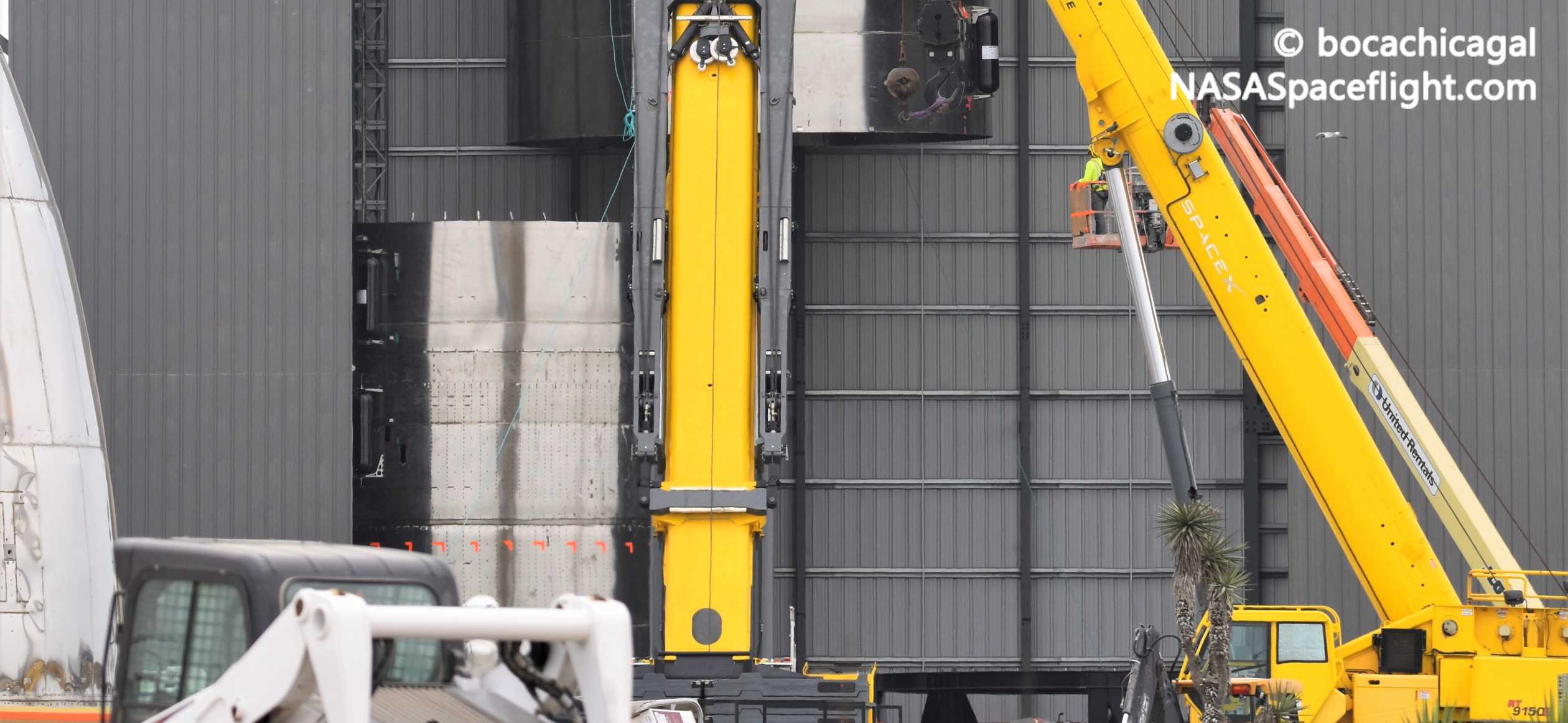
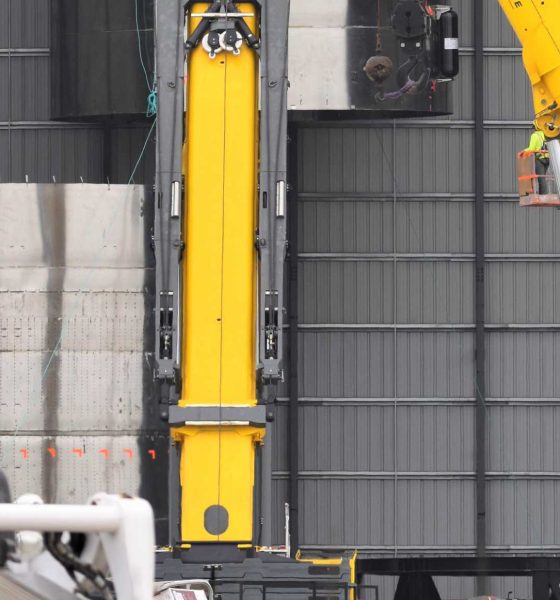
News
SpaceX Starship rocket could move to the launch pad today
SpaceX has finished stacking its fourth full-scale Starship prototype and public schedules show that the rocket could be moved to a nearby launch and test pad as early as April 20th.
Known as Starship serial number 4 (SN4), the rocket will be the third full-scale vehicle completed since the start of serial production, while Starship Mk1 – the first full-scale prototype – was built far more slowly and with different methods. Mk1 was destroyed during one of its first cryogenic liquid nitrogen ‘proof’ tests in November 2019, nearly nine months after assembly began in February. After Mk1’s failure, SpaceX spent about two months rapidly expanding and upgrading its Boca Chica, Texas Starship factory.
Around the end of January 2020, SpaceX kicked off the production of its first serial prototype – logically deemed SN1. Less than a month after its first steel rings were stacked and welded together, SpaceX transported the completed prototype to the launch pad. On February 28th, what CEO Elon Musk later described as a fault in its engine section “thrust puck” destroyed Starship SN1 during one of its first cryogenic proof tests. Barely a month later and after SN2 was modified into a “thrust puck” test tank and successfully tested, Starship SN3 rolled to the launch pad and was destroyed by operator and test design errors on April 3rd. Now, barely two weeks after SN3, Starship SN4 is about to begin testing.
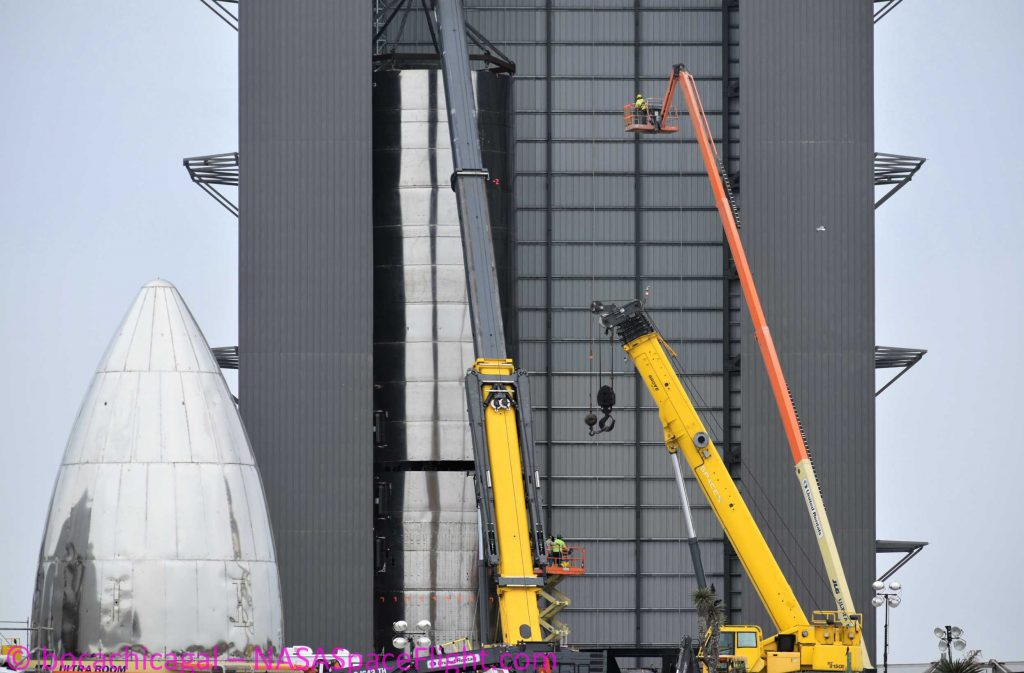
By all appearances, work on Starship SN4 began around March 23rd, continuing a production schedule that has been consistently completing a full-scale rocket prototype every four or so weeks. While SpaceX has taken the unprecedented step of reusing a section of a prototype (SN3) destroyed during testing, every other aspect of the rocket is new and built more or less from scratch.
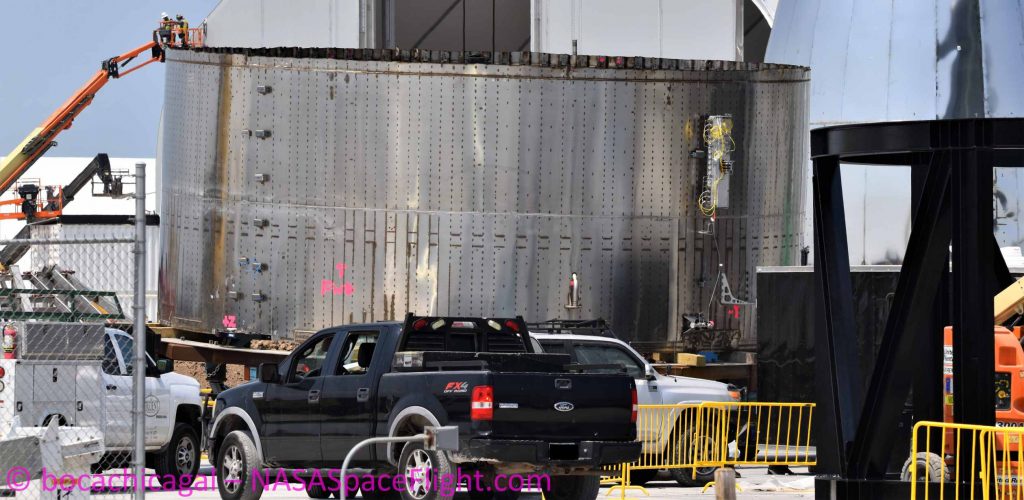
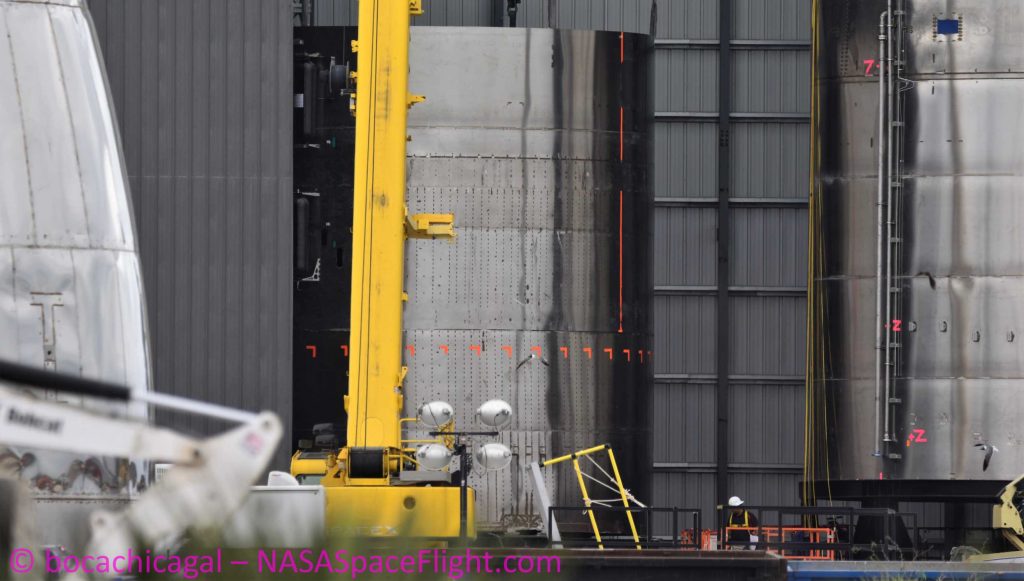
Just two days after Starship SN3’s salvaged skirt and SN4’s new engine section and aft liquid oxygen tank dome were stacked and welded together, SpaceX technicians attached a crane to the upper two-thirds of the rocket’s tank section and stacked it on top of the newly-finished engine section. 24 hours later, SpaceX teams have completed at least one circumferential seam weld, with a second soon to be finished.
Once that last weld is complete and passes inspections, Starship SN4 will be ready to be lifted onto a transporter and rolled down the road to SpaceX’s dedicated launch and test facilities. Of course, like SN3 and SN1 before it, SpaceX will likely still have a few days of work to get Starship SN4 ready for testing once it’s been moved to the pad.
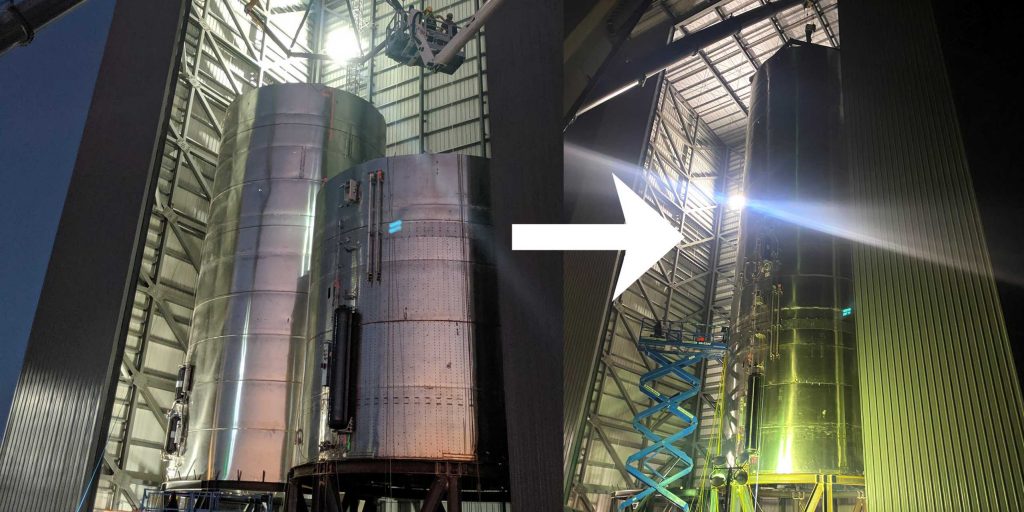
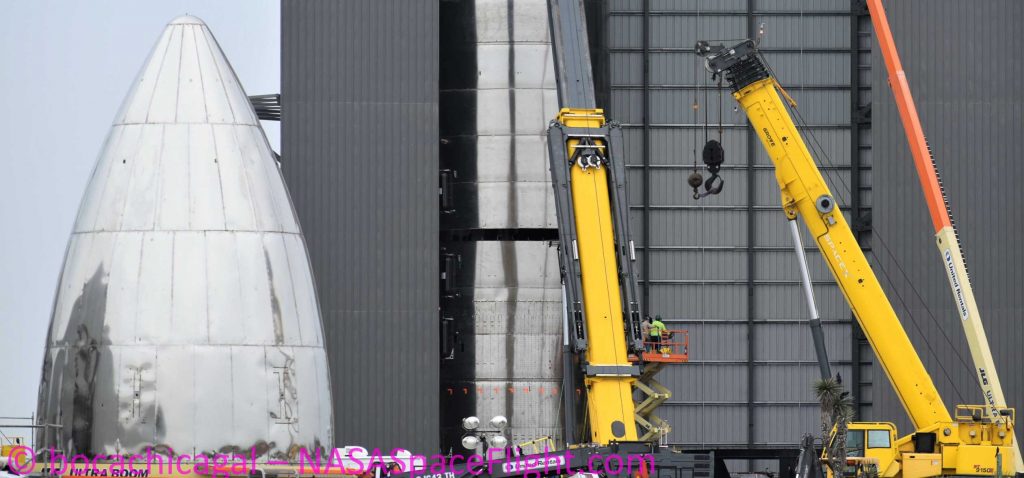
Using Starship SN3’s timeline, Starship SN4 could be transported to the pad as early as April 19th or 20th and ready for testing by April 24th or 25th. This meshes well with a publicly-available road closure schedule, required because SpaceX often needs to close a public highway for certain Starship transport and testing operations. Per Cameron County’s website, SpaceX has a transport-related closure planned on April 20th. The first testing-related closure begins on Sunday, April 26th and lasts from 9am to midnight, with backups on Monday and Tuesday.
As always, delays should come as no surprise with prototype testing, and schedules are always fluid and liable to change at any second. Regardless, it looks like Starship SN4 is perhaps just a week from its first round of testing.

News
Nvidia CEO Jensen Huang explains difference between Tesla FSD and Alpamayo
“Tesla’s FSD stack is completely world-class,” the Nvidia CEO said.

NVIDIA CEO Jensen Huang has offered high praise for Tesla’s Full Self-Driving (FSD) system during a Q&A at CES 2026, calling it “world-class” and “state-of-the-art” in design, training, and performance.
More importantly, he also shared some insights about the key differences between FSD and Nvidia’s recently announced Alpamayo system.
Jensen Huang’s praise for Tesla FSD
Nvidia made headlines at CES following its announcement of Alpamayo, which uses artificial intelligence to accelerate the development of autonomous driving solutions. Due to its focus on AI, many started speculating that Alpamayo would be a direct rival to FSD. This was somewhat addressed by Elon Musk, who predicted that “they will find that it’s easy to get to 99% and then super hard to solve the long tail of the distribution.”
During his Q&A, Nvidia CEO Jensen Huang was asked about the difference between FSD and Alpamayo. His response was extensive:
“Tesla’s FSD stack is completely world-class. They’ve been working on it for quite some time. It’s world-class not only in the number of miles it’s accumulated, but in the way it’s designed, the way they do training, data collection, curation, synthetic data generation, and all of their simulation technologies.
“Of course, the latest generation is end-to-end Full Self-Driving—meaning it’s one large model trained end to end. And so… Elon’s AD system is, in every way, 100% state-of-the-art. I’m really quite impressed by the technology. I have it, and I drive it in our house, and it works incredibly well,” the Nvidia CEO said.
Nvidia’s platform approach vs Tesla’s integration
Huang also stated that Nvidia’s Alpamayo system was built around a fundamentally different philosophy from Tesla’s. Rather than developing self-driving cars itself, Nvidia supplies the full autonomous technology stack for other companies to use.
“Nvidia doesn’t build self-driving cars. We build the full stack so others can,” Huang said, explaining that Nvidia provides separate systems for training, simulation, and in-vehicle computing, all supported by shared software.
He added that customers can adopt as much or as little of the platform as they need, noting that Nvidia works across the industry, including with Tesla on training systems and companies like Waymo, XPeng, and Nuro on vehicle computing.
“So our system is really quite pervasive because we’re a technology platform provider. That’s the primary difference. There’s no question in our mind that, of the billion cars on the road today, in another 10 years’ time, hundreds of millions of them will have great autonomous capability. This is likely one of the largest, fastest-growing technology industries over the next decade.”
He also emphasized Nvidia’s open approach, saying the company open-sources its models and helps partners train their own systems. “We’re not a self-driving car company. We’re enabling the autonomous industry,” Huang said.
Elon Musk
Elon Musk confirms xAI’s purchase of five 380 MW natural gas turbines
The deal, which was confirmed by Musk on X, highlights xAI’s effort to aggressively scale its operations.

xAI, Elon Musk’s artificial intelligence startup, has purchased five additional 380 MW natural gas turbines from South Korea’s Doosan Enerbility to power its growing supercomputer clusters.
The deal, which was confirmed by Musk on X, highlights xAI’s effort to aggressively scale its operations.
xAI’s turbine deal details
News of xAI’s new turbines was shared on social media platform X, with user @SemiAnalysis_ stating that the turbines were produced by South Korea’s Doosan Enerbility. As noted in an Asian Business Daily report, Doosan Enerbility announced last October that it signed a contract to supply two 380 MW gas turbines for a major U.S. tech company. Doosan later noted in December that it secured an order for three more 380 MW gas turbines.
As per the X user, the gas turbines would power an additional 600,000+ GB200 NVL72 equivalent size cluster. This should make xAI’s facilities among the largest in the world. In a reply, Elon Musk confirmed that xAI did purchase the turbines. “True,” Musk wrote in a post on X.
xAI’s ambitions
Recent reports have indicated that xAI closed an upsized $20 billion Series E funding round, exceeding the initial $15 billion target to fuel rapid infrastructure scaling and AI product development. The funding, as per the AI startup, “will accelerate our world-leading infrastructure buildout, enable the rapid development and deployment of transformative AI products.”
The company also teased the rollout of its upcoming frontier AI model. “Looking ahead, Grok 5 is currently in training, and we are focused on launching innovative new consumer and enterprise products that harness the power of Grok, Colossus, and 𝕏 to transform how we live, work, and play,” xAI wrote in a post on its website.
Elon Musk
Elon Musk’s xAI closes upsized $20B Series E funding round
xAI announced the investment round in a post on its official website.

xAI has closed an upsized $20 billion Series E funding round, exceeding the initial $15 billion target to fuel rapid infrastructure scaling and AI product development.
xAI announced the investment round in a post on its official website.
A $20 billion Series E round
As noted by the artificial intelligence startup in its post, the Series E funding round attracted a diverse group of investors, including Valor Equity Partners, Stepstone Group, Fidelity Management & Research Company, Qatar Investment Authority, MGX, and Baron Capital Group, among others.
Strategic partners NVIDIA and Cisco Investments also continued support for building the world’s largest GPU clusters.
As xAI stated, “This financing will accelerate our world-leading infrastructure buildout, enable the rapid development and deployment of transformative AI products reaching billions of users, and fuel groundbreaking research advancing xAI’s core mission: Understanding the Universe.”
xAI’s core mission
Th Series E funding builds on xAI’s previous rounds, powering Grok advancements and massive compute expansions like the Memphis supercluster. The upsized demand reflects growing recognition of xAI’s potential in frontier AI.
xAI also highlighted several of its breakthroughs in 2025, from the buildout of Colossus I and II, which ended with over 1 million H100 GPU equivalents, and the rollout of the Grok 4 Series, Grok Voice, and Grok Imagine, among others. The company also confirmed that work is already underway to train the flagship large language model’s next iteration, Grok 5.
“Looking ahead, Grok 5 is currently in training, and we are focused on launching innovative new consumer and enterprise products that harness the power of Grok, Colossus, and 𝕏 to transform how we live, work, and play,” xAI wrote.








